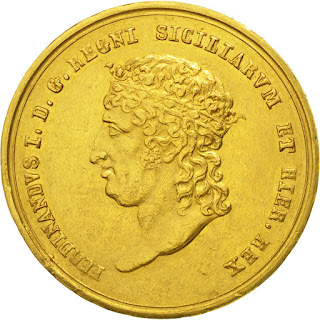Italian States Naples & Sicily 15 Ducati Gold Coin 1818 Ferdinand I of the Two Sicilies
Fifteen Ducati or Five Oncette Piece of Ferdinand I.
Obverse: Crowned head of Ferdinand I of the Two Sicilies, facing to the right.
Legend: " FERDINANDVS I. DEI GRATIA REX " (Ferdinand I., by the grace of God, King.)
Exergue: Date of the year of issue.
Reverse: An angel, full figure, beside a column, upon which lies a cushion, and upon the cushion a royal crown, the right hand of the angel resting upon the cushion, his left hand resting on an oval shield, upon which are the three lilies of the Bourbon dynasty.
Exergue: "TRAPP 21 25/100 TITOLO MILLESIMI 996 DUCATI 15" (Trappesi 21 25/100 equal to 292.180 grains Troy. Millesimi 996, equal to 996 fine; Ducati 15 = 15 Ducats.)
Weight: 292.180 grains.
Fineness: 996.
King Ferdinand I of the Two Sicilies
Ferdinand I, (born Jan. 2/12, 1751, Naples — died Jan. 4, 1825, Naples), king of the Two Sicilies (1816–25) who earlier (1759–1806), as Ferdinand IV of Naples, led his kingdom in its fight against the French Revolution and its liberal ideas. A relatively weak and somewhat inept ruler, he was greatly influenced by his wife, Maria Carolina of Austria, who furthered the policy of her favourite adviser, the Englishman Sir John Acton.
Ferdinand became king of Naples as a boy when his father ascended the Spanish throne (1759) as Charles III. A regency ruled during Ferdinand’s minority and continued the liberal reforms of the previous king. In 1767 Ferdinand reached his majority, and his marriage in 1768 to Maria Carolina signalled a reversal of this policy. The birth of a male heir gave Maria Carolina the right, according to the marriage contract, to enter the council of state (1777). She brought about the downfall of the former regent Bernardo Tanucci and engaged Naples in the Austro-English coalition against the French Revolution in 1793.
Ferdinand, encouraged by the arrival of the British fleet of Admiral Horatio Nelson, attacked the French-supported Roman republic in 1798. On December 21 of that year, however, the French invaded Naples, declaring it the Parthenopean Republic, and Ferdinand fled to Sicily. The Republic was overthrown in June 1799, and Ferdinand returned to Naples, where he put to death the Republic’s supporters, violating the terms of their surrender.
In 1806 Napoleon’s army captured Naples, forcing Ferdinand’s flight to Sicily, where, yielding to British pressure to mitigate his absolutist rule, he removed Maria Carolina from the court, appointed his son Francis as regent, and granted the Sicilians a constitution. With the fall of Napoleon, he returned to Naples as Ferdinand I of the united kingdom of the Two Sicilies (December 1816). His renewal of absolute rule led to the constitutionalist uprising of 1820, which forced Ferdinand to grant a constitution. Having ceded power again to his son Francis, Ferdinand, under the pretext of protecting the new constitution, obtained his parliament’s permission to attend the Congress of Laibach early in 1821. Once there, he won the aid of Austria, which overthrew Naples’ constitutional government in March. The subsequent reprisals against the constitutionalists were his last important official acts before his sudden death.

